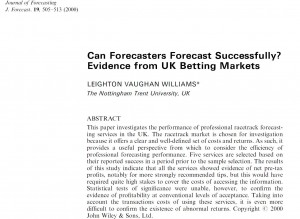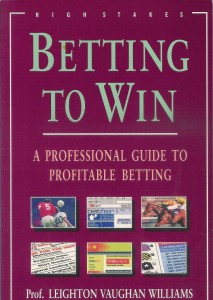 I am occasionally blog on a paper that is of interest. Well, of interest to me. The latest paper to catch my eye is (other papers I have commented on can be seen here).
I am occasionally blog on a paper that is of interest. Well, of interest to me. The latest paper to catch my eye is (other papers I have commented on can be seen here).
Leighton Vaughan Williams (2000) Can Forecasters Forecast Successfully?: Evidence from UK Betting Markets, Journal of Forecasting, 19(6), 505-513 (doi).
The reason that this paper was of interest is because I was reading Leighton’s book (Betting to Win : A Professional Guide to Profitable Betting, High Stakes Publishing, 2002, ISBN: 1-84344-015-6) and this paper was mentioned. Many (many, many) years ago, long before I was an academic, I went through a phase where I collected all sort of horse racing systems. My idea was to test them all out to see if any of them worked. I never actually placed a bet and I never really tested any systems as they generally involved too much time to collect all the data, process the data etc. etc.
Since then I have still thought that it would be interesting to look at various horse racing systems to see if they worked.
This is what this paper does. Unlike my idea though, it takes tips from services that you subscribe to, either by paying money or by contacting them using a premium rate phone service. This seems a lot more sensible, rather than having to enter all the data yourself.
This paper looks at the performance of tipping services, with the analysis being carried out in 1995. Five services were compared. Four of these were subscription based. That is a fee is paid, and you gets tips at various times. In 1995, these services cost at least 99 GBP per month, which seems a lot to me now, let alone in 1995. The other service was a premium rate phone number, where you phone up to receive the tip and the costs of the phone call effectively covers the cost of the service. These five services were chosen as they were amongst the top tipping services as assessed by the Racing Information Database (I have tried to google this and am not sure that it is in existence anymore, but would be willing to be corrected, and update this post to provide a link).
The paper goes through each of the tipping services and evaluates how many tips were provided (and over what period – some, for example, were analysed over three months, others over six months – I think the period was probably chosen to ensure that a sufficient number of tips were analysed as not all services provide tips at the same interval), any conditions associated with the service (for example, only bet if a certain price is available), the profit (or loss) from investing in that service etc.
The good news is that all the tipping services produced a pre-tax profit when used with the relevant staking/price plans. Leighton also makes the point that none of these profits could be said to be significant. It was also interesting to note that increased profits could have been achieved if some of the lesser supported tips were ignored. Of course, this would be a hindsight examination and the obvious question would be, when in play, what tips do you ignore, and what ones do you actively bet upon? There is also evidence that you should use a variable staking plan, rather than a flat stakes method.
If you use a tipping service, there are also other factors to take into account. There is an upfront investment (which you may never recover). Unlike an academic study, you will probably only choose one and which one do you choose? There is also (as pointed out by Leighton, in chapter 20 of his book) the fact that you have to take what the tipping services advertise with a pinch of salt. As an example, a service might only say bet if you can get a price of 4-1 or better. What happens if that price is almost impossible (or even actually impossible) to get, will the service still include that in their results if the horse should win? And what if there was a price available (even for a few seconds) at 6-1, would the service return that as the price you could have got even though, unless you were very quick, or very lucky, you would have struggled to get on at 6-1.
It is twelve years since the paper was published, and seventeen years since the analysis was carried out and things have moved on. Tipping services (I suspect) come and go, technology has moved on, the tax regime has changed and there are now many other ways to bet which were not so predominant at the time. I am thinking specifically of spread betting and betting exchanges. These have, undoubtedly, made a big difference to the industry.
I am not up to date with the scientific literature in the area of sports forecasting and I suspect that there are many papers out there that provide various comparisons and analysis. If you know of any, or know of a good review paper in this area, I would be very interested if you could post a comment giving the reference.
I would also be interested in hearing from any professional tipping services (no matter what sport, but UK based as I don’t claim to understand American sports or markets) who wish to subject their service to scientific analysis. Note, this is not an open invite to advertise your service on this blog. I get enough spam as it is (and moderate it out) and I don’t want the comments box filled up with lightly disguised adverts to various web sites that claim to make millionaires from people who subscribe. But serious enquiries are welcomed.
